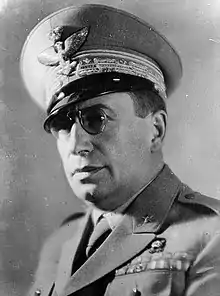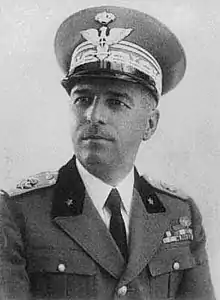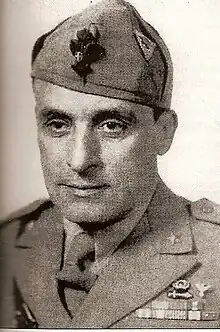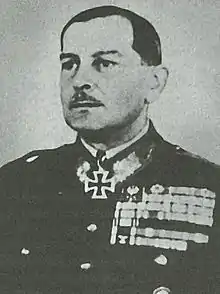| World War II |
|---|
| Navigation |
|
| Timelines of World War II |
|---|
| Chronological |
| Prelude |
| By topic |
The Commanders of World War II were for the most part career officers. They were forced to adapt to new technologies and forged the direction of modern warfare. Some political leaders, particularly those of the principal dictatorships involved in the conflict, Adolf Hitler (Germany), Benito Mussolini (Italy), and Hirohito (Japan), acted as dictators for their respective countries or empires.[1]
Military commanders
Allied Forces
United Kingdom
France
| Armed Force | Name | Highest Rank | Highest Award | Commands | Fate | Theatres / Battles | |
|---|---|---|---|---|---|---|---|
| Army | Charles de Gaulle |  |
Général de Brigade | Grand Master Legion of Honor | Commander, 4th Armored Division
Leader of the Free French Forces Chairman of the Provisional Government of the French Republic |
Took control of France as President and was instrumental in creating the Provisional Government of the French Republic and later the Fifth French Republic. | |
| Defied Vichy France by vowing to continue fighting after the French surrender. He headed with de Tassigny the Free French Forces, who assisted the Allies in the liberation of France in 1944.[1] | |||||||
| Jean de Lattre de Tassigny |  |
Marshal of France | Grand Master Legion of Honor | Commander, First Army
Commander-in-Chief, Ground Forces in Western Europe |
Later commanded the French Far East Expeditionary Corps in the First Indochina War. | ||
| Defied Vichy France by vowing to continue fighting after the French surrender. He headed with Charles de Gaulle the Free French Forces, who assisted the Allies in the liberation of France in 1944.[1] | |||||||
| Alphonse Juin |  |
Marshal of France | Grand Cross Legion of Honor | Commander, 15th Motorized Infantry Division | Became Resident General in Morocco and member of the Académie Française, Allied Joint Force Commander Brunssum in NATO | ||
| Commander of the Vichy French forces in North Africa until 1942, then commander of the French Expeditionary Corps in Tunisia and Italy.[1] | |||||||
| Maurice Gamelin |  |
Général d'Armée | Grand Cross Legion of Honor | Chief of Staff of the French Army | Died in 1958. | ||
| Commander-in-Chief of French army during Battle of France, was replaced on 20 May 1940.[1] | |||||||
| Maxime Weygand |  |
Général d'armée | Grand Cross Legion of Honor | Chief of Staff of the French Army | Arrested on charges of treason but acquitted. | ||
| Commander-in-Chief of French army during the Battle of France from 20 May 1940 until the surrender of France. Oversaw the creation of the Weygand line, an early application of the Hedgehog tactic.[1] | |||||||
| French Navy | François Darlan |  |
Admiral of the Fleet | War Cross | Chief of Staff of the French Navy | Assassinated by Fernand Bonnier de La Chapelle December 1942. | |
| Built up the French Navy to prepare for war, only to see it destroyed by the British Navy. Served the Vichy France government and was tipped to become Pétain's successor. Was commander of Vichy French forces in Operation Torch. After arranging a ceasefire, he defected to the Allied side.[1] | |||||||
United States
| Armed Force | Name | Highest Rank | Highest Award | Command | Fate | Theatres / Battles | |
|---|---|---|---|---|---|---|---|
| Army | George Marshall |  |
General of the Army | Distinguished Service Medal, Silver Star | Chief of Staff of the United States Army | As United States Secretary of State his name was given to the Marshall Plan, for which he was awarded the Nobel Peace Prize in 1953. Also served as Secretary of Defense during the Korean War. | |
| Was the aide to General John J. Pershing after World War I. Was Chief of Staff having overall command of the US Army during and before World War II. Marshall served as the U.S. Army Chief of Staff during the war and as the chief military adviser to President Franklin D. Roosevelt. Many of the American generals that were given top commands during the war were either picked or recommended by Marshall, including Dwight Eisenhower, Lloyd Fredendall, Lesley J. McNair, Mark W. Clark and Omar Bradley.[4] He led the rapid growth of US forces, co-ordinated the Western Allies and promoted postwar reconstruction of Europe.[1] | |||||||
| Dwight D. Eisenhower |  |
General of the Army | Army Distinguished Service Medal, Navy Distinguished Service Medal. | Commanding General, European Theater of Operations | After liberating Europe, served as Army Chief of Staff, president of Columbia University, and Supreme Commander of NATO before being elected the 34th President of the United States. | ||
| In December 1943, President Roosevelt decided that Eisenhower—not Marshall—would be Supreme Allied Commander in Europe. The following month, he resumed command of European Theater of Operations United States Army (ETOUSA) and the following month was officially designated as the Supreme Allied Commander of the Supreme Headquarters Allied Powers Europe (SHAPE), serving in a dual role until the end of hostilities in Europe in May 1945. He was charged in these positions with planning and carrying out the Allied assault on the coast of Normandy in June 1944 under the code name Operation Overlord, to head the liberation of Europe on the Western Front and the invasion of Germany. | |||||||
| Douglas MacArthur |  |
General of the Army | Medal of Honor, Philippine Medal of Valor | United States Military Advisor to the Philippines
Commanding General, United States Army Forces in the Far East |
Tasked with rebuilding Japan after the war. Later commanded the United Nations Command in the Korean War, and was controversially dismissed by President Harry S. Truman for considering the use of nuclear weapons against China and North Korea. Considered possible Republican Party candidate in 1952 United States presidential election, and chaired Remington Rand | ||
| Recalled from retirement prior to the start of the Pacific war. Early on in World War II, received the Medal of Honor for extreme bravery. Was disappointed to relinquish the Philippines to the Japanese. Promising to return, he did so in 1945 and whilst in Manila, prepared for war in Japan itself. MacArthur presided over the Japanese Unconditional Surrender in 1945. His strategy of maneuver, air strikes and force avoidance meant that soldiers under his command faced relatively low casualties. | |||||||
| Omar Bradley |  |
General of the Army | Distinguished Service Medal (Army and Navy). | Commanding General, 82nd Airborne Division | Promoted to General of the Army during the Korean War (after serving in the rank of General during World War II). Became Chairman of the Joint Chiefs of Staff. | ||
| This former infantry school instructor entered the war under Patton, later becoming his boss. Towards the end of the war, led a force of over 1.3 million troops (America's largest to serve under one man).[1] | |||||||
| Mark W. Clark |  |
General | Distinguished Service Medal (Army and Navy). | Commanding General, II Corps
Commanding General, Fifth Army |
Commanded the United Nations Command at the end of the Korean War. Served as President of the Citadel from 1954 to 1965. | ||
| Led the triumphal entry into Rome. Served under General Harold Alexander. Ordered the destruction of the religious abbey at Monte Cassino. Was commander-in-chief in Italy from late 1944.[1] | |||||||
| George S. Patton, Jr. | .jpg.webp) |
General | Distinguished Service Cross | Commanding General, Desert Training Center
Commanding General, Seventh Army Commanding General, First Army Group Commanding General, Third Army |
Died in a road accident 4 months after the end of the war. | ||
| An aggressive general whose ferocious military thrusts earned him admiration and respect from many participants in the war (and at times endangered his military career). Successfully used the German tactic of armored blitzkrieg against the Germans.[1] | |||||||
| Navy | Ernest King | .jpg.webp) |
Fleet Admiral | Navy Cross | Commander-in-Chief, United States Atlantic Fleet | Retired on December 15, 1945. | |
| [1] United States Chief of Naval Operations. | |||||||
| Chester W. Nimitz |  |
Fleet Admiral | Legion of Honour, Distinguished Service Medal | Commander-in-Chief, United States Pacific Fleet | Served as Chief of Naval Operations. | ||
| After the attack on Pearl Harbor, took command of the Pacific Ocean areas, and turned around USA's fortunes in the Battle of Midway. Closed the war with operations in the Leyte Gulf and Okinawa.[1] | |||||||
| William Halsey, Jr. |  |
Fleet Admiral | Navy Cross | Commander, Carrier Division 2 | Retired 1947. | ||
| Commander of South Pacific Area 1942–1944. Commander of United States Third Fleet 1944–1945.[1][5] | |||||||
| Frank Jack Fletcher |  |
Admiral | Medal of Honor | Commander, Task Force 14 | Chairman of the General Board, retired in 1947. | ||
|
Recipient of the Medal of Honor for saving hundreds of refugees during the United States occupation of Veracruz in April 1914 during the Mexican Revolution. Operational commander at the pivotal Battles of Coral Sea and of Midway; nephew of Admiral Frank Friday Fletcher. In November 1942, he became Commander, Thirteenth Naval District and Commander, Northwestern Sea Frontier. Later, he was placed in charge of the Northern Pacific area.[1] | |||||||
| Raymond A. Spruance | .jpg.webp) |
Admiral | Navy Cross | Commander, Task Force 16
Deputy Commander-in-Chief, United States Pacific Fleet Commander, Central Pacific Force Commander-in-Chief, United States Pacific Fleet and Pacific Ocean Areas |
Served as President of the Naval War College. | ||
| Commander of two significant battles during the war, Battle of Midway and the Battle of the Philippine Sea. | |||||||
| USAAF | Henry Arnold |  |
General of the Air Force | Distinguished Service Medal | Chief of the United States Army Air Forces
Deputy Chief of Staff for Air |
||
| Member of the US Joint Chiefs of Staff, and the Combined Chiefs of Staff committees.[1] | |||||||
| Ira C. Eaker |  |
General | Distinguished Service Medal (Army, Navy and Air Force) | Commander, Eighth Air Force
Commander of Air Operations, Mediterranean Theater of Operations Deputy Commander of the United States Army Air Forces |
Became deputy commander of the Army Air Forces until retirement in 1947. | ||
| Commander of the 8th US Bomber command.[1] | |||||||
| Carl Spaatz | 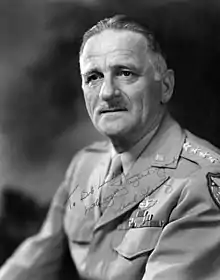 |
General | Air Force Cross | Commander, Air Combat Command
Commander of Air Operations, European Theater |
Replaced Arnold in September 1947 to become chief of the US Air Force. | ||
| One of the pioneers of US military aviation, Spaatz advocated the use of scientific analysis to bombing raids, and made effective use of long range fighters, tactics which helped the Allies achieve air superiority over Europe.[1] | |||||||
Soviet Union
| Armed Force | Name | Highest Rank | Highest Award | Fate | Theatres / Battles | ||
|---|---|---|---|---|---|---|---|
| Army | Georgy Zhukov |  |
Marshal of the Soviet Union | Twice an Order of Victory, four times Hero of the Soviet Union | Chief of the General Staff of the Red Army | Became Soviet member of the Allied Control Council for Germany, influential in removal of Lavrentiy Beria and selection of Nikita Khrushchev as First Secretary after the death of Joseph Stalin, Minister of Defense of the Soviet Union 1955–57, member of the 20th Presidium of the Communist Party of the Soviet Union 1956-1957 | |
| Involved in nearly every major battle on the Eastern Front. He successfully led the defense of Moscow and later relieved Leningrad. After vying with Rokossovsky for overall command, he led all Soviet armies in the closing stages of the war and at the Battle for Berlin.[1] | |||||||
| Aleksandr Vasilevsky | 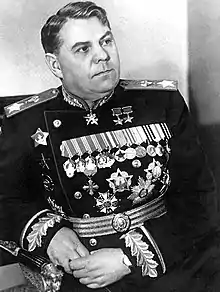 |
Marshal of the Soviet Union | Twice an Order of Victory, twice Hero of the Soviet Union. | Chief of the General Staff of the Red Army
Deputy People's Commissar for Defense of the Soviet Union Commander-in-Chief, Soviet Forces in the Far East |
Chief of Staff of the Soviet Army, Soviet Defence Minister | ||
| Stalin's strategic specialist who planned and carried through many successful Soviet operations as overall commander, particularly the encirclement at Stalingrad and the grand plan for Bagration. Commander-in-Chief of Soviet Forces in the Far East during Manchurian Strategic Offensive Operation.[1] | |||||||
| Konstantin Rokossovsky |  |
Marshal of the Soviet Union, Marshal of Poland | Order of Victory, twice Hero of the Soviet Union. | Commander, 9th Mechanized Corps
Commander, Central Front and 1st Belorussian Front |
Commanded the Northern Group of Forces during the Soviet occupation of Poland and the beginning of the Cold War. Appointed Minister of National Defense of the Communist Polish People's Republic. | ||
| Decisive role in the Battle for Moscow, led encirclement forces at Stalingrad, broke German counter-attack at Kursk, advanced into Poland and eventually linked up with the Americans at Wismar.[1] | |||||||
| Boris Shaposhnikov |  |
Marshal of the Soviet Union | Three Orders of Lenin | Chief of the General Staff of the Red Army | Commandant of the Voroshilov Military Academy. Died in 1945. | ||
| Chief of the General Staff 1937–1940, 1941–1942. Organized pre-war buildup of the Red Army. | |||||||
| Ivan Bagramyan |  |
Marshal of the Soviet Union | Twice Hero of the Soviet Union. | Soviet Army commander | |||
| Bagramyan's experience in military planning as a chief of staff allowed him to distinguish himself as a capable commander in the early stages of the Soviet counter-offensives against Nazi Germany. | |||||||
| Nikolai Vatutin |  |
General of the Army | Hero of the Soviet Union | Commander, Voronezh Front | Killed by the Ukrainian Insurgent Army. | ||
| Deputy of the Chief of the General Staff of the Red Army. Played a decisive role at Kursk, outmanoeuvered German commander Manstein and later routed German forces in Korsun salient.[1] | |||||||
| Ivan Konev | 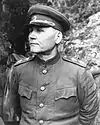 |
Marshal of the Soviet Union | Order of Victory, Twice Hero of the Soviet Union | Commander, 19th Army
Commander, 2nd Ukrainian Front Commander, 1st Ukrainian Front Commander, Group of Soviet Occupation Forces in East Germany |
Appointed head of the Soviet forces in the Soviet occupation zone of Germany. Served as Commander-in-Chief of the Soviet Armed Forces and Supreme Commander of the Unified Armed Forces of the Warsaw Treaty Organization during the Hungarian Revolution of 1956, the Berlin Crisis of 1961, and the Warsaw Pact invasion of Czechoslovakia |
| |
| Played a pivotal role in the War, retaking much of Eastern Europe. Helped in the capture of Berlin, the capital of Nazi Germany. Konev was also a competitor of Marshal Georgy Zhukov.[1] | |||||||
| Semyon Timoshenko |  |
Marshal of the Soviet Union | Order of Victory, Twice Hero of the Soviet Union. | Commander, Kiev Military District
Commander, Leningrad Military District |
Commanded the Belorussian Military District (Soviet Armed Forces in the Byelorussian Soviet Socialist Republic) | ||
| Defence Commissar till 19 July 1941. Chairman of the Stavka (Soviet High Command). A capable commander in the early stages of World War II. Played a decisive role in the Winter War and the invasion of Poland. After the defeat Kharkov, Timoshenko was removed by Stalin from front-line command but given overall command in different fronts of the USSR. | |||||||
| Soviet Navy | Ivan Isakov |  |
Admiral of the Fleet of the Soviet Union | Hero of the Soviet Union | Chief-of-Staff of the Soviet Navy | Chief of Staff of the Soviet Navy, Deputy People's Commissar of the Navy | |
| Nikolay Kuznetsov | 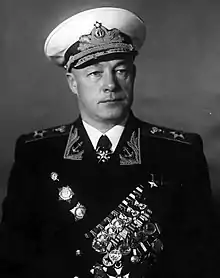 |
Admiral of the Fleet of the Soviet Union | Hero of the Soviet Union | People's Commissar of the Navy | People's Commissar of the Navy during The Second World War | ||
| Ivan Yumashev | 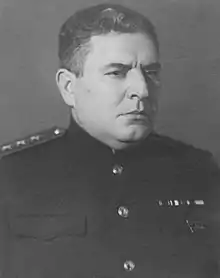 |
Admiral | Hero of the Soviet Union | Commander-in-Chief, Pacific Fleet | Commander of Soviet Pacific Fleet | ||
| Soviet Aviation | Sergei Khudyakov |  |
Marshal of Aviation of the Soviet Union | Order of Lenin | Chief of Staff of the Soviet Air Force | Chief of Staff of the Soviet Air Force, deputy commander of the Air Force | |
| Alexander Novikov | 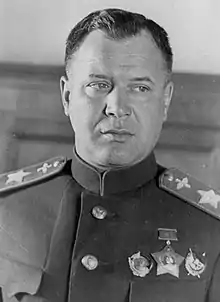 |
Chief Marshal of Aviation of the Soviet Union | Two times Hero of the Soviet Union | Chief of Staff of the Soviet Air Force | Commander of the Air Forces of the Soviet UnionChief of the High school of civil aviation | ||
| Alexander Golovanov |  |
Chief Marshal of Aviation of the Soviet Union | Commander, 18th Air Army | Commander of the Long Range Aviation | |||
Army: Filipp Golikov
Australia
| Armed Force | Name | Highest Rank held during World War II |
Highest Award | Command | Fate | Theatres / Battles | |
|---|---|---|---|---|---|---|---|
| Army | Vernon Sturdee |  |
Lieutenant General | Knight Commander of the Order of the British Empire | Chief of the General Staff |
|
Chief of General Staff and then Commander in Chief |
| Brudenell White | .jpg.webp) |
General | Knight Commander of the Order of the Bath | Chief of the General Staff | Killed in the Canberra air disaster, 1940. | ||
| Chief of the General Staff (March–August 1940) | |||||||
| Thomas Blamey |  |
General | Knight Grand Cross of the Order of the British Empire | General Officer Commanding, Second Australian Imperial Force
General Officer Commanding, I Corps |
Promoted to Field Marshal in 1950. Became an author and promoted welfare of ex-servicemen. | ||
| Commander-in-chief of Australian Armed Forces and commander-in-chief of Allied Land Forces in the South West Pacific Area. | |||||||
| Edmund Herring |  |
Lieutenant General | Knight Commander of the Order of the British Empire | General Officer Commanding, 6th Division
General Officer Commanding, 7th Military District General Officer Commanding, Northern Territory Force General Officer Commanding, II Corps |
Later Chief Justice of Australia. Received KCMG in 1949. | ||
| Commander of Australian forces in the Kokoda Track campaign. | |||||||
| Leslie Morshead | .jpg.webp) |
Lieutenant General | Knight Commander of the Order of the Bath | General Officer Commanding, 18th Infantry Brigade
General Officer Commanding, 9th Division General Officer Commanding, II Corps General Officer Commanding, New Guinea Force |
Became General Manager of the Orient Steam Navigation Company. | ||
| Led the Australian defence against Rommel's in siege of Tobruk. Commander at the Battle of El Alamein. Australia forces took 22 percent of the casualties there. After learning the art of jungle warfare, he became the commander of operations against the Japanese in New Guinea. | |||||||
| Air Force | Charles Burnett |  |
Air Chief Marshal | Knight Commander of the Order of the Bath | Inspector-General of the Royal Air Force | RAF officer loaned to Australia and served as Chief of the Air Staff from 1940 to 1942. Oversaw a 20-fold increase in the size of the RAAF which supported the Empire Air Training Scheme. Returned to Great Britain in 1942 and while suffering poor health worked in the RAF's cadet organisation, the Air Training Corps. Died of a coronary thrombosis months before the end of the War. | |
| Fighter ace during the First World War. Deputy Commander of RAF in the Middle East. | |||||||
| Air Force | Peter Roy Maxwell Drummond |  |
Air Marshal | Knight Commander of the Order of the Bath | Deputy Air Officer Commanding-in-Chief RAF Middle East | Died in an air crash at sea, 1945. | |
| Fighter ace during the First World War. Deputy Commander of RAF in the Middle East. | |||||||
| Navy | John Gregory Crace |  |
Vice Admiral | Knight Commander of the Order of the British Empire | Commander, ANZAC Squadron | Commanded Chatham Dockyard in Britain. | |
| Commanded the Australian navy in the Battle of the Coral Sea. Commander of the Allied Naval Squadron, ANZAC Force. | |||||||
Canada
| Armed Force | Name | Highest Rank | Highest Award | Fate | Theatres / Battles | ||
|---|---|---|---|---|---|---|---|
| Army | Harry Crerar |  |
General | Order of the Companions of Honour | General Officer Commanding, 2nd Canadian Infantry Division
General Officer Commanding, I Canadian Corps |
Became a diplomat, postings in Czechoslovakia, Netherlands and Japan. | |
| De facto commander-in-chief of the Canadian military.[1] | |||||||
| Guy Simonds |  |
Lieutenant General | Companion of the Order of Canada | General Officer Commanding, 1st Canadian Infantry Division | In 1951 he was appointed Chief of the General Staff | ||
| Devised the Kangaroo armoured personnel carrier.[1] | |||||||
| Andrew McNaughton |  |
Lieutenant General | Order of the Companions of Honour | General Officer Commanding, 1st Canadian Infantry Division
General Officer Commanding, VII Corps General Officer Commanding, Canadian Corps General Officer Commanding, I Canadian Corps |
First President of the United Nations Security Council | ||
| A noteworthy scientist and inventor of a direction finding device for artillery, a precursor to Radar. Fought in Vimy Ridge during World War I and was a lieutenant colonel. Commander of the Canadian troops until 1943. Was defeated in the Dieppe Raid. Opposed the breaking up of the Canadian Army, and insisted it fight as a single unit. Grandfather of Lieutenant-General Andrew Leslie of Canada.[1] | |||||||
| Air Force | George Croil |  |
Air Marshal | Commander of the Most Excellent Order of the British Empire | Chief of the Air Staff of the Royal Canadian Air Force
Inspector-General of the Royal Canadian Air Force |
Died in 1959 in Vancouver, British Columbia. | |
| Croil succeeded in obtaining the RCAF's independence from the Army just before the war. He was Chief of the Air Staff from 1938 to 1940 and Inspector-General of the Royal Canadian Air Force from 1940 to 1944. | |||||||
| Lloyd Samuel Breadner |  |
Air Chief Marshal | Companion of the Order of the Bath | Chief of the Air Staff of the Royal Canadian Air Force | Retired after the war. Died in 1952 in Boston, Massachusetts. | ||
| A decorated Royal Naval Air Service pilot in World War I, Breadner served as Chief of the Air Staff from 1940 to 1943 and Air Officer Commanding-in-Chief RCAF Overseas from 1944 to 1945. He was one of only two Canadian air chief marshals, the other being Frank Robert Miller. | |||||||
South Africa
| Armed Force | Name | Highest Rank held during World War II |
Highest Award | Command | Fate | Theatres / Battles | |
|---|---|---|---|---|---|---|---|
| Army | Evered Poole |  |
Major-General | Companion of the Order of the British Empire | General Service Officer Grade 1, 1st Infantry Division
General Service Officer Grade 1, 2nd Infantry Division General Officer Commanding, 2nd Infantry Brigade General Officer Commanding, 6th Armoured Division General Officer Commanding, South African Forces in Allied Central Mediterranean Force |
Passed over as Chief of Staff in 1948 by the newly elected National Party. Posted as head of the South African military mission in Berlin, before embarking on a successful diplomatic career. In 1960, he became ambassador to Greece. | |
| Commanded the 6th Armoured Division upon its formation in February 1943, and led the division throughout the Italian campaign until 1945. He was among the very few South Africans to be invested as a Commander of the United States Legion of Merit, and was invested as a Commander of the French Legion of Honour. He also received the French Croix de Guerre. | |||||||
| Dan Pienaar |  |
Major-General | Companion of the Order of the British Empire | General Officer Commanding, 1st Infantry Brigade
General Officer Commanding, 1st Infantry Division |
Killed in an air crash near Lake Victoria, Kenya on his way back to South Africa in December 1942. Pienaar was arguably one of South Africa's most charismatic and popular military commanders. An infantry regiment, the exhibition hall at the South African National Museum of Military History and a suburb of his home town, Bloemfontein, were later named after him. | ||
| Fought in the East African Campaign, and led the 1st South African Infantry Division in the Western Desert. He was recorded by the press after El Alamein as saying, "Rommel will not get to Alexandria, he will not get the Canal, and he will never dine in Cairo - unless as a tourist." | |||||||
| George Brink |  |
General | Companion of the Order of the British Empire | General Officer Commanding, 1st Infantry Division
General Officer Commanding-in-Chief, Inland Area Command |
Declared unfit for field duty and recalled to South Africa. Although he retired from the military in 1946, Brink led South Africa's demobilisation efforts from 1944 to 1948. | ||
| From 1940, Brink commanded the 1st South African Division during the East African Campaign, and later commanded the division during the Western Desert Campaign in North Africa. In 1942, Brink turned over command of the division to Dan Pienaar after being declared unfit for field duty due to a back injury. | |||||||
| Hendrik Klopper |  |
General | Distinguished Service Order | General Officer Commanding, 3rd Infantry Brigade | Escaped from captivity in 1943 and was later exonerated by a 1942 Court of Inquiry into the Tobruk disaster, however, Klopper never commanded in the field again.
Officer Commanding the South African Army College from 1944 to 1945, before being appointed in command of Northern Command in 1945. From 1951 to 1953, Klopper served as Army Chief of Staff, as Inspector-General from 1953 to 1956, and as Commandant General of the Union Defence Force from 1956 to 1958. |
||
| Briefly commanded the 2nd South African Infantry Division from May to June 1942, and was tasked as Fortress Commander of Tobruk. Forced to surrender the Tobruk garrison to Axis forces, with over 30,000 British and Commonwealth troops being taken prisoner. Klopper later escaped from captivity in 1943 and returned to South Africa. | |||||||
| Isaac Pierre de Villiers | Major-General | Companion of the Order of the British Empire | General Officer Commanding, 2nd Infantry Division | Retired in 1945, became Chairman of the Immigrants Selection Board from 1946 to 1948. | |||
| Commanded the 2nd South African Infantry Division between 1940 and 1942, later overseeing Coastal Area Command in South Africa until 1945. Relinquished command of the 2nd SA Division just one month before the Fall of Tobruk where over 10,000 South Africans were taken prisoner by Axis forces. | |||||||
| Air Force | Pierre van Ryneveld | General | Knight Commander of the Order of the Bath | Chief of the General Staff of the Union Defence Force
Founder of the South African Air Force |
Retired in 1949 after serving as CGS for sixteen years, including the whole of the Second World War. The Pretoria suburb of Pierre van Ryneveld Park was named in his honour and the airport just north of Upington in the Northern Cape is also named after Van Ryneveld. Sir Pierre van Ryneveld High School is in Kempton Park, Gauteng. The SAAF's annual air power symposium, is known as the Sir Pierre Van Ryneveld Air Power Symposium. | ||
| Established the SAAF in 1920 and directed it until 1933, when he was promoted to Chief of the General Staff (CGS), in command of the Union Defence Forces. However, for the next four years, the SAAF remained under Van Ryneveld's direct control as no one was appointed as the Air Force's director until 1937. | |||||||
| Air Force | Jimmy Durrant | Major-General | Companion of the Order of the British Empire | Officer Commanding, No. 40 Squadron SAAF
Officer Commanding, No. 24 Squadron SAAF Officer Commanding, No. 205 Group RAF Air Officer Commanding, No. 231 Group SAAF |
In 1946, he became Director-General of the South African Air Force and qualified on a special course at the Imperial Defence College in 1951. He resigned from the SAAF as a result of the de-anglicisation policy instituted by the National Party after they took power after the 1948 general election. | ||
| Appointed officer commanding of No. 40 Squadron SAAF, which he commanded in East Africa from May 1940 to September 1941 when was promoted lieutenant-colonel and appointed officer commanding 24 Squadron SAAF. He commanded this squadron throughout the bitter fighting in the Western Desert Campaign in 1941–42. Later promoted colonel and given command of 3 (Bomber) Wing SAAF in North Africa, Sicily and Italy. In 1945, he was posted to the Far East as AOC No. 231 Heavy Bomber Group, RAF, with the rank of major-general. At the age of 32, he was the youngest major-general in the Allied forces. | |||||||
| Navy | Guy Hallifax |  |
Rear Admiral | Order of St Michael and St George | Killed in an air crash at Baboon Point, 74 kilometres (46 mi) north of Saldanha while returning from a tour of inspection to the newly established naval detachment in Walvis Bay in March 1941. |
| |
| Instrumental in overseeing large-scale industrial and administrative expansion of the South African Navy between 1939 and 1941, as well as assuming operational responsibility from the Royal Navy for the first time. | |||||||
New Zealand
| Armed Force | Name | Highest Rank held during World War II |
Highest Award | Command | Fate | Theatres / Battles | |
|---|---|---|---|---|---|---|---|
| Army | Bernard Freyberg, 1st Baron Freyberg |  |
Lieutenant General | Knight Grand Cross of the Order of St Michael and St George, Distinguished Service Order Holder of the Victoria Cross plus three other Distinguished Service Orders (World War I) |
General Officer Commanding, New Zealand Expeditionary Force | Returned to New Zealand and later became Governor-General of New Zealand | |
| A veteran of the Mexican Revolution and Victoria Cross recipient during the First World War. First soldier on beach for the Battle of Gallipoli during the First World War and the youngest general in the British Army during the First World War.[6] He liked to be in the thick of action—Churchill called him "the Salamander" due to his love of fire. Involved in the defeat in the Battle of Greece. Again defeated as the Allied Commander in the Battle of Crete after Churchill failed to provide enigma intelligence. Very successful as a commander in various campaigns in the North African Campaign, including the Battle of El Alamein. Defeated again at the Battle of Cassino as a Corps Commander (this is nonsense-the Germans lost at Cassino-how could Freyberg be defeated?). Relieved Padua and Venice, and was first to enter Trieste in the race for Trieste, and successfully confronted Josip Broz Tito's Partisans there. By the end of World War II, Freyberg had spent ten and a half years fighting the Germans during both the second and first world wars.[7] | |||||||
| Air Force | Arthur Coningham | .jpg.webp) |
Air Marshal | Knight Commander of the Order of the Bath | Air Officer Commanding, No. 4 Group RAF
Air Officer Commanding-in-Chief, Western Desert Air Force Air Officer Commanding-in-Chief, Northwest African Tactical Air Force |
Missing in Bermuda Triangle. | |
| A high scoring air ace in World War I. Air force Commander working with famous Major General George Patton during Operation Torch. Commander of tactical Air Forces for Operation Husky and D-Day. | |||||||
| Keith Park |  |
Air Chief Marshal | Knight Grand Cross of the Order of the Bath | Air Officer Commanding, No. 11 Group RAF
Air Officer Commanding, No. 23 Group RAF Air Officer Commanding-in-Chief, Air Headquarters Egypt Air Officer Commanding-in-Chief, Air Headquarters Malta Air Officer Commanding-in-Chief, Middle East Command Air Officer Commanding-in-Chief, Air Command South East Asia |
Returned to New Zealand. | ||
| A veteran of World War I and air ace. Served under Hugh Dowding and commanded the defense of London during the Luftwaffe attacks. Dowding and Park are credited with winning the Battle of Britain. Led the defense of Malta. | |||||||
| Roderick Carr |  |
Air Marshal | Knight Commander of the Order of the British Empire | Air Officer Commanding, No. 4 Group RAF | Air Officer Commanding Indian Air Force, 1946 | ||
| Served in the Royal Naval Air Service during the First World War. Commander of Northern Ireland RAF. Bomber Command Commander 4 Group. Deputy Chief of Staff (Air), SHAEF. | |||||||
Poland
| Armed Force | Name | Highest Rank | Highest Award | Command | Fate | Theatres / Battles | |
|---|---|---|---|---|---|---|---|
| Army | Edward Rydz-Śmigły |  |
Marshal of Poland | Order of the White Eagle | General Inspector of the Polish Armed Forces | Suffered heart attack before he could participate in the Polish resistance. | |
| Was commander-in-chief of Poland during its invasion by German and Russian troops.[1] | |||||||
| Władysław Sikorski |  |
General | Order of the White Eagle | General Inspector of the Polish Armed Forces | Died in plane crash July 1943. | ||
| Served as Commander-in-Chief of the Polish government in exile, and formed the Polish Armed Forces.[1] | |||||||
| Władysław Anders | 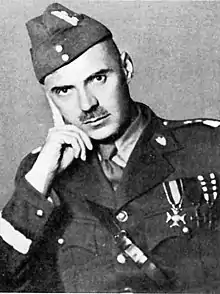 |
General | Order of the White Eagle | Commander, Nowogródzka Cavalry Brigade | Became Inspector-General of the Polish Armed Forces in Exile. | ||
| Founder & commander of the Polish Forces Armed in Iran (1942), better known as Anders Army.[1] | |||||||
| Michał Rola-Żymierski |  |
Marshal of Poland | Order of the Builders of People's Poland | Commander-in-Chief, Polish Armed Forces in the East
Minister of National Defense of the Provisional Government of the Republic of Poland |
He was a member of the Polish United Workers Party | ||
| Was commander-in-chief of the Polish Army fighting alongside the Soviet Union.[1] | |||||||
| Tadeusz Bór-Komorowski |  |
Lieutenant General | Order of the White Eagle | Commander-in-Chief, Home Army | Elected Prime Minister of Polish government in Exile. | ||
| Commanded the main part of the Warsaw Uprising.[1] | |||||||
| Franciszek Kleeberg |  |
Major General | Virtuti Militari | Commander, Independent Operational Group Polesie | He was one of the officers of the Polish Legion against the Soviets. He was imprisoned in Oflag IV-B Königstein and died in 1941. | ||
| The last remaining Polish General holding the Germans off until the battle of Kock, he had never lost a battle until Kock.[8] | |||||||
Czechoslovakia
| Armed Force | Name | Highest Rank | Highest Award | Commands | Fate | Theatres / Battles | |
|---|---|---|---|---|---|---|---|
| Army | Ludvík Svoboda | General | People's Hero of Yugoslavia, Hero of the Soviet Union | Commander-in-Chief, 1st Czechoslovak Army Corps in the Soviet Union | Later president of the Czechoslovak Socialist Republic. | ||
| Commander of the Czechoslovak military units on the Eastern front | |||||||
| Ján Golian |  |
Brigadier General | Czechoslovak War Cross | Executed by the Germans in a concentration camp in Flossenburg. | |||
| Led the insurgent Slovak Army during the Slovak National Uprising. | |||||||
Greece
Netherlands
| Armed Force | Name | Highest Rank | Highest Award | Commands | Fate | Theatres / Battles | |
|---|---|---|---|---|---|---|---|
| Army | Henri Winkelman |  |
General | Military William Order | Chief of Defence of the Netherlands Armed Forces | Died in 1952. | |
| Was Commander-in-Chief of the Netherlands army during the Battle of the Netherlands.[1] | |||||||
| Hein ter Poorten |  |
Lieutenant General | Commander-in-Chief, Royal Netherlands East Indies Army | He spent the rest of the war in various prisoner of war camps, and in 1945 returned to the Netherlands. Died in 1968. | |||
| Commander of the ABDA land forces in early 1942. | |||||||
| Navy | Conrad Helfrich | .jpg.webp) |
Vice Admiral | Knight Grand Cross of the Order of the Netherlands Lion | Commander of the Royal Netherlands Navy | Died in 1962. | |
| Commander of the ABDA Naval forces in 1942. | |||||||
| Karel Doorman |  |
Rear admiral | Knight of the Military William Order | Commander, American-British-Dutch-Australian Combined Striking Force | Died in Battle of the Java Sea. | ||
| Commander of the combined American, British, Dutch and Australian (ABDA) fleet in the Dutch East Indies.[1] | |||||||
Luxembourg
| Armed Force | Name | Highest Rank | Highest Award | Commands | Fate | Theatres / Battles | |
|---|---|---|---|---|---|---|---|
| Army | Émile Speller | Major-Commandant | Order of the Oak Crown | Chief of Defence | Arrested by Germany in 1940 following the invasion of Luxembourg but later released, died 17 January 1952[9] | ||
Yugoslavia
| Armed Force | Name | Highest Rank | Highest Award | Commands | Fate | Theatres / Battles | |
|---|---|---|---|---|---|---|---|
| Army | Draža Mihailović |  |
General of the Army | Legion of Merit | Commander of the Chetnik Detachments of Yugoslav Army | Executed by Communists in 1946. | |
| Led the Chetniks. | |||||||
| Josip Broz Tito |  |
Marshal | Order of the National Hero | President of the League of Communists of Yugoslavia
Commander-in-Chief of the Yugoslav Partisans Founder of Democratic Federal Yugoslavia and the Socialist Federal Republic of Yugoslavia |
Became President of Yugoslavia | ||
| Led the People's Liberation Army.[1] | |||||||
China
| Armed Force | Name | Highest Rank | Highest Award | Commands | Fate | Theatres / Battles | |
|---|---|---|---|---|---|---|---|
| Army | Chiang Kai-shek | 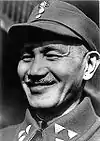 |
Generalissimo | Order of National Glory | Premier of the Republic of China
Commander-in-Chief of the National Revolutionary Army |
After the war against Japan, resumed Chinese Civil War against the communists. Retreated to Taiwan and led the Kuomintang (KMT) government there until his death. | |
| Was both the head of the Republic of China and the supreme Allied commander in the China Theatre. Led the nation to total war from his temporary capital at Chongqing. | |||||||
| Yan Xishan |  |
General | Order of Blue Sky and White Sun | Commander of the National Revolutionary Army in Shanxi | Fought on the side of the Republic of China in the civil war. | ||
| Warlord of Shanxi | |||||||
| Chen Cheng |  |
General | Order of Blue Sky and White Sun | Commander-in-Chief, Chinese Expeditionary Force | Became the Chief of the general staff. | ||
| Zhu De |  |
Marshal of the People's Republic of China | Honour Sabre of the Awakened Lion | Commander-in-Chief, Chinese Red Army | Became the commander-in-chief of the People's Liberation Army. | ||
| Military leader of the Communist Eighth Route Army. | |||||||
| Xue Yue |  |
General | Order of Blue Sky and White Sun | Commander, 19th Army Group
Commander, Eastern Henan Army Commander, 1st Army Corps Commander, 9th Front |
Fought on the side of the Republic of China in the civil war. | ||
| Li Zongren |  |
General | Order of Blue Sky and White Sun | Commander of the KMT Fifth War Zone | Became the Vice President of the Republic of China. | ||
| Bai Chongxi |  |
General | Order of Blue Sky and White Sun | Became the Minister of National Defence of the Republic of China. | |||
| Navy | Chen Shaokuan |  |
Fleet Admiral | Order of Blue Sky and White Sun | Chief of Navy of the Republic of China Navy | Became the Minister of Navy of the Republic of China, the Vice Governor of Fujian Province of the People's Republic of China |
|
| Chen Ce | 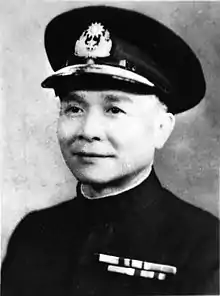 |
Admiral | Order of the British Empire |
| |||
| Shen Honglie |  |
Admiral | Order of Blue Sky and White Sun | ||||
Axis Forces
Germany
| Armed Force | Name | Highest Rank | Highest Award | Commands | Fate | Theatres / Battles | |
|---|---|---|---|---|---|---|---|
| Army | Wilhelm Keitel |  |
Field Marshal | Knight's Cross of the Iron Cross | Chief of the Oberkommando der Wehrmacht | Executed in 1946. | |
| Chief of the OKW during World War II. Was convicted of war crimes in the Nuremberg Trials and executed by the Allies.[1] | |||||||
| Alfred Jodl | 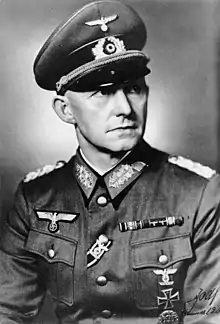 |
Colonel General | Knight's Cross of the Iron Cross | Chief of the Operations Staff of the Oberkommando der Wehrmacht | Executed in 1946. | ||
| Chief of the Operations Staff of the OKW.[1] | |||||||
| Heinrich Himmler |  |
Reichsführer-SS | Blood Order, Golden Nazi Party | Reichsfuhrer-SS
Chief of German Police |
Chief of the SS during World War II.[1] Suicide, 1945. | ||
| Military commander and a leading member of the Nazi Party (NSDAP) of Nazi Germany. Nazi leader Adolf Hitler later appointed him Commander of the Replacement (Home) Army and General Plenipotentiary for the administration of the entire Third Reich. Himmler was one of the most influential men in Nazi Germany and one of the persons most directly responsible for the Holocaust. | |||||||
| Walther von Brauchitsch |  |
Field Marshal | Knight's Cross of the Iron Cross | Supreme Commander of the German Army | Died in 1948. | ||
| Commander-in-Chief of the German Army 1938–1941. | |||||||
| Paul Ludwig Ewald von Kleist |  |
Field Marshal | Knight's Cross with Oak Leaves and Swords | Commander, 1st Panzer Army | Died in 1954 in a Soviet prison. Most senior German officer to die in a Soviet prison. | ||
| An aristocrat and senior commander in World War I. Commander of tank armies in the German Army in World War II. Fought in most of the actions involving blitzkrieg techniques. | |||||||
| Wilhelm Ritter von Leeb |  |
Field Marshal | Knight's Cross of the Iron Cross | Commander-in-Chief, Army Group C | Died in 1956. | ||
| Exemplary service in World War I. Given the command of Army Group North in Operation Barbarossa. Was in charge of the unsuccessful siege of Leningrad, which lasted nearly 1000 days. | |||||||
| Gerd von Rundstedt |  |
Field Marshal | Knight's Cross with Oak Leaves and Swords | Commander-in-Chief, Army Group South | Died in 1953. |
| |
| A Kriegsakademie graduate of the Prussian nobility, and a major World War I veteran, Rundstedt distinguished himself as commander of numerous fronts of World War II including the Western and Eastern fronts of Europe.[1] | |||||||
| Günther von Kluge |  |
Field Marshal | Knight's Cross with Oak Leaves and Swords | Commander, 4th Army | Committed suicide in 1944. | ||
| Commander of many successful operations including the invasion of Poland, France and the Soviet Union. Involved in the failed Hitler assassination, he decided to commit suicide.[1] | |||||||
| Georg von Küchler |  |
Field Marshal | Knight's Cross with Oak Leaves | Commander, 18th Army | Arrested in 1948 and sent to the Soviet Union by the Americans. Released in 1953. | ||
| Relieved von Leeb as commander of the siege of Leningrad. After this failed, withdrew Army Group North, which prevented its destruction.[1] | |||||||
| Fedor von Bock |  |
Field Marshal | Knight's Cross of the Iron Cross | Commander-in-Chief, Army Group North
Commander-in-Chief, Army Group B |
Was killed by a British fighter pilot in 1945 and became the only one of two of Adolf Hitler's field marshal's to die from enemy fire. | ||
| Recipient of the Pour le Mérite from World War I, rose rapidly in rank to field marshal by the fall of France. Took command of Army Group Centre, whose Panzer groups penetrated the furthest into Russia. Was one of the senior Wehrmacht commanders before the outbreak of war. Play a decisive role in the defeat of Poland and France. Bock was German Army Group Center commander during Operation Barbarossa, after the defeat at Moscow was relieved of command by Hitler. After Reichenau death, he was appointed to take over Army Group South. He was instructmental in defeating Marshal Timoshenko forces at Kharkov. However, Hitler was displeased with Bock and dismissed him. Played no further part in the war[1] | |||||||
| Erich von Manstein |  |
Field Marshal | Knight's Cross of the Iron Cross with Oakleaves and Swords | Commander, 18th Infantry Division | Imprisoned after war, later released and served as senior advisor to the Bundeswehr. | ||
| The master of mobile battle, authored the original Sichelschnitt plan, a plan which enabled Germany to capture France with minimal casualties. Manstein captured Sevastapol and was responsible for shoring up the Southern Front after the defeat at Stalingrad. He later recaptured Kharkov. After the defeat at Kursk, he successfully handled his army group retreat. However, he was dismissed by Hitler after frequently clashing with him in 1944. He then played no further part in the war from then on.[1] | |||||||
| Erwin Rommel | .jpg.webp) |
Field Marshal | Pour le Mérite, Knight's Cross of the Iron Cross with Oakleaves, Swords and Diamonds | Commander, 7th Panzer Division | Committed suicide after being implicated in the Valkyrie plot. Official cause of death by the State was succumbing to wounds from an Allied air attack. |
| |
| Nicknamed The Desert Fox, Rommel headed the German campaign of North Africa. Rommel was highly decorated in World War I with the Pour le Mérite, Germany's highest award. During World War II, he made an immediate impact in the Saharan desert, conquering all of West Africa and threatening to reach Suez. A number of factors such as stretching supply lines and the reinforcement of Allied military power (both in Morocco and Egypt) turned the tide in the favour of the Allies, and his forces were routed in the Battle of Tunisia in 1943. Before he could counterattack, German high command reassigned him to defend the Atlantic Wall. Rommel failed to stop the allied invasion of Normandy. Though typically linked to the assassination of Hitler, Rommel likely did not take part in the July 20 plot as he did not want future generations to think that the Axis lost the war due to backstabbing. Nevertheless, Rommel committed suicide in order to avoid trial after the war.[1] | |||||||
| Walter Model |  |
Field Marshal | Knight's Cross of the Iron Cross with Oakleaves, Swords and Diamonds | Commander, 3rd Panzer Division
Commander-in-Chief, Army Group North Commander-in-Chief, Army Group North Ukraine Commander-in-Chief, Army Group Centre |
Committed suicide in 1945. |
| |
| German Army officer whose expertise in defensive warfare earned him the nickname of the 'Führer's fireman'[1] | |||||||
| Heinz Guderian |  |
Colonel General | Knight's Cross of the Iron Cross with Oak Leaves | Commander, 2nd Panzer Division
Acting Chief of the Oberkommando des Heeres |
Died in 1954. | ||
| Early pioneer of Blitzkrieg tactics. Chief of OKH General Staff 1944–1945.[1] | |||||||
| Friedrich Paulus | 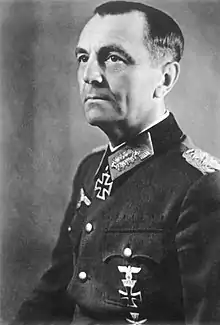 |
Generalfeldmarschall | Knight's Cross of the Iron Cross with Oak Leaves | Deputy Chief of the Oberkommando des Heeres | Soviet captivity until 1953. Became a vocal critic of the Nazi regime. | ||
| Commander of the disastrous campaign in the Battle of Stalingrad. | |||||||
| Josef Dietrich |  |
SS-Oberst-Gruppenführer und Generaloberst der Waffen-SS | Knight's Cross of the Iron Cross with Oakleaves, Swords and Diamonds | Commander, Leibstandarte SS Adolf Hitler Commander, I SS Panzer Corps Commander, 5th Panzer Army Commander, 6th Panzer Army |
Sentenced to life, reduced to 25 years imprisonment in 1946. Promoted welfare of ex-servicemen on release. | ||
| Before World War II, Dietrich was very close to Hitler, commanded his bodyguard unit, was a member of the Prussian State Council, and played a key part in the Night of the Long Knives. In World War II, he became the commander of 1st SS Panzer Division Leibstandarte SS Adolf Hitler and General of the Waffen-SS. Dietrich came into prominence for his role in the Battle of the Bulge in late 1944. He later commanded the defense of Vienna. He was a widely respected person in Germany both during and after the war.[1] | |||||||
| Air force | Hermann Göring |  |
Reichsmarschall | Grand Cross of the Iron Cross | Reichsmarschall of the Greater German Reich (supreme commander of the Wehrmacht)
Chief of the Oberkommando der Luftwaffe |
Committed suicide after being sentenced to death for war crimes. | |
| Was a high scoring air ace and took over the Red Baron's famous squadron, and won the prestigious Pour le Mérite in World War I. Hitler's second in command. Commander-in-Chief of Luftwaffe 1935–1945. He was involved with the running of Germany and the war, including implementation of the Holocaust.[1] | |||||||
| Albert Kesselring |  |
Field Marshal | Knight's Cross of the Iron Cross with Oakleaves, Swords and Diamonds | Commander, Luftflotte 1 | Died in 1960 at the age of 75. | ||
| Was commander-in-chief of Luftwaffe South (1941–1943), then South-west (1943–1945), then West Europe (1945). Chief of the defense of Italy against the allies during the prolonged battles of Anzio and Monte Cassino. Was a leader in the defense of Germany at the end of the war. Kesselring was admired by both sides of the war and was responsible for protecting priceless artworks and even the City of Rome from destruction.[1] | |||||||
| Wolfram Freiherr von Richthofen | .jpg.webp) |
Field Marshal | Knight's Cross of the Iron Cross with Oak Leaves | Commander, 8th Air Corps | Died in 1945. | ||
| Robert Ritter von Greim |  |
Field Marshal | Knight's Cross of the Iron Cross with Oakleaves, Swords and Diamonds | Commander, 5th Air Corps
Chief of the Oberkommando der Luftwaffe |
Committed suicide in 1945. | ||
| An ace of World War I and winner of the prestigious Pour le Mérite award. Before World War II, went to China to help build their air force. A commander of the Luftwaffe during the Battle of Poland. He was loyal to Hitler to the end, flying in on 26 April 1945 with Hanna Reitsch. He and Hanna Reitsch said "It was the blackest day when we could not die at our Führer's side.".[1] | |||||||
| Kurt Student |  |
General | Knight's Cross of the Iron Cross with Oakleaves | Commander, 1st Parachute Division | Held as a Prisoner of War by the British and freed in 1948. | ||
| An ace of World War I. Before World War II, trained troops in airborne operations. Commanded the successful airborne operations in the Battle of Crete. Commanded the highly successful operation to free Benito Mussolini. Successful again in the defense against airborne landings near Arnhem.[1] | |||||||
| Navy | Erich Raeder |  |
Grand Admiral | Knight's Cross of the Iron Cross | Chief of the Oberkommando der Marine | Died in 1960. | |
| Commander-in-Chief of Kriegsmarine 1936–1943.[1] | |||||||
| Karl Dönitz |  |
Grand Admiral | Knight's Cross of the Iron Cross with Oak Leaves | Befehlshaber der U-Boote
Chief of the Oberkommando der Marine |
Briefly became President of Germany. Spent 10 years in prison. Died in 1980. | ||
| Commander-in-Chief of Kriegsmarine 1943–1945.[1] | |||||||
Italy
Japan
| Armed Force | Name | Highest Rank | Highest Award | Commands | Fate | Theatres / Battles | |
|---|---|---|---|---|---|---|---|
| Army | Hideki Tojo | 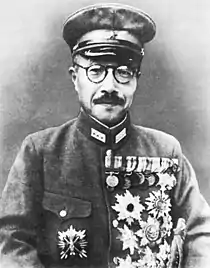 |
General | Order of the Rising Sun | Prime Minister of Japan | Executed in 1948. | |
| Prime minister of Japan and President of the Imperial Rule Assistance Association in 1941-1944 was also a military commander. Chief of the Army General Staff in 1944.[1] | |||||||
| Hajime Sugiyama |  |
Field Marshal | Order of the Rising Sun | Minister of the Army
Inspector-General of Military Training Commander North China Area Army Commander Mongolia Garrison Army |
Committed suicide shortly after the end of the war. | ||
| Chief of the Army General Staff 1940–1944.[1] | |||||||
| Prince Kotohito Kan'in |  |
Field Marshal | Order of the Chrysanthemum | Chief of Imperial Japanese Army General Staff | Died in 1945 | ||
| Chief of staff of the Army, 1931–1940 | |||||||
| Hisaichi Terauchi |  |
Field Marshal | Order of the Rising Sun | Commander, Taiwan Army of Japan | Died in a prisoner of war camp in Malaya June 1946. | ||
| Son of former PM Terauchi Masatake, became the senior officer of the Imperial Japanese after the coup of 1936. Was at one time considered as Tojo successor after the latter's resignation. | |||||||
| Shunroku Hata |  |
Field Marshal | Order of the Rising Sun | Commander, 14th Division
Commander, Taiwan Army of Japan Inspector-General of Military Training Commander, Central China Expeditionary Army |
Sentenced to imprisonment. | ||
| Commanded the Second General Army, based in Hiroshima from 1944 to 1945 in preparation for the anticipated Allied invasion of the Japanese home islands. | |||||||
| Tomoyuki Yamashita | 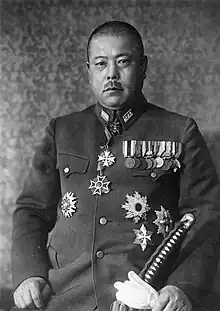 |
General | Order of the Rising Sun | Commander, 3rd Imperial Infantry Regiment | Executed at 1946. | ||
| Forced the surrender of the allies in the Battle of Singapore. Defender of the Philippines against MacArthur. an American military tribunal in Manila tried General Yamashita for war crimes relating to the Manila Massacre and many atrocities in the Philippines and Singapore against civilians and prisoners of war, such as the Sook Ching massacre, and sentenced him to death. This controversial case has become a precedent regarding the command responsibility for war crimes and is known as the Yamashita Standard.[1] | |||||||
| Iwane Matsui |  |
General | Order of the Rising Sun | Commander, 11th Division
Commander, Taiwan Army of Japan |
Retired 1938, executed in 1948. | ||
| Arrested by the American occupation authorities after the surrender of Japan, Matsui was charged with war crimes in connection with the actions of the Japanese army in China also known as The Nanking Massacre. In 1948, the International Military Tribunal for the Far East (IMTFE) found him guilty of class B and C war crimes, and he was hanged that December at Sugamo Prison, alongside six others, including Hideki Tojo. He was 70 at the time of his death. | |||||||
| Navy | Osami Nagano | 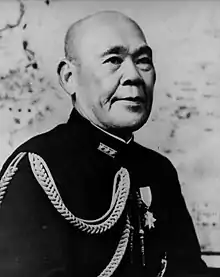 |
Fleet Admiral | Order of the Rising Sun | Minister of the Navy
Chief of Imperial Japanese Navy General Staff |
Died of a heart attack in 1947. | |
| Chief of the Navy General Staff, 1941–1944. | |||||||
| Prince Fushimi Hiroyasu |  |
Fleet Admiral | Order of the Chrysanthemum | Chief of Imperial Japanese Navy General Staff | Died in 1946. | ||
| Chief of staff of the Navy, 1932–1941. | |||||||
| Isoroku Yamamoto |  |
Fleet Admiral | Order of the Chrysanthemum | Director of the Imperial Japanese Navy Aviation Bureau | The plane carrying him was shot down in 1943. |
| |
| Commander of the Dec. 7, 1941 Attack on Pearl Harbor, Hawaii. Commander-in-Chief of the Imperial Japanese Navy 1939–1943. Isoroku Yamamoto, was killed on Bougainville Island when his transport bomber aircraft was shot down by United States Army Air Forces fighter aircraft operating from Kukum Field on Guadalcanal.[1] | |||||||
| Mineichi Koga |  |
Fleet Admiral | Order of the Rising Sun | Vice Chief of the Imperial Japanese Navy General Staff | Killed in plane crash 1944. | ||
| Commander-in-Chief of the Imperial Japanese Navy 1943–1944.[1] | |||||||
| Soemu Toyoda |  |
Admiral | Order of the Rising Sun | Commander-in-Chief, 4th Fleet
Commander-in-Chief, Kure Naval District |
Died in 1957 at the age of 73. | ||
| Commander-in-Chief of the Imperial Japanese Navy 1944–1945, Chief of staff of the Navy 1945.[1] | |||||||
| Chūichi Nagumo |  |
Admiral | Order of the Rising Sun | Commander-in-Chief, 1st Air Fleet
Commander-in-Chief, Sasebo Naval District Commander-in-Chief, Kure Naval District Commander-in-Chief of Central Pacific Area Fleet and 14th Air Fleet |
Committed suicide in 1944 during the battle of Saipan. | ||
| Torpedo specialist and commander of the Carrier Striking Task Force that attacked Pearl Harbor. Successful raids at Darwin and the Indian Ocean were reversed at the Battle of Midway. Although he had tactical victories in the Guadalcanal campaigns, his battle strength was severely depleted, and was switched to the defence of the Mariana Islands.[1] | |||||||
| Jisaburō Ozawa |  |
Vice Admiral | Order of the Sacred Treasure | Commander-in-Chief, Combined Fleet | Died in 1966. | ||
| Replaced Toyoda in 1945 to become commander-in-chief of the Japanese Combined Fleet[1] | |||||||
Army: Korechika Anami
Hungary
Thailand
| Armed Force | Name | Highest Rank | Highest Award | Commands | Fate | Theatres / Battles | |
|---|---|---|---|---|---|---|---|
| Army | Plaek Phibunsongkhram |  |
Field Marshal | Order of the Nine Gems | Commander of the Royal Thai Army | Later ousted after the defeat of the Japanese, only to return to power in 1948 and become prime minister until 1957. | |
| Prime Minister and dictator of Thailand during the war, eventually commanding Thai forces during the French-Thai War. | |||||||
| Jarun Rattanakun Seriroengrit | 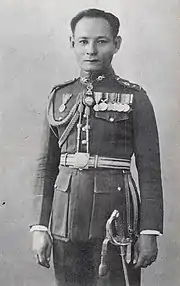 |
Lieutenant general | Order of the Crown of Thailand | Commander, Phayap Army | Commander of an infantry battalion and took part in the invasion and occupation of the Shan States in Burma. | ||
| Commander of Phayap Army during the Pacific War. | |||||||
Romania
| Armed Force | Name | Highest Rank | Highest Award | Commands | Fate | Theatres / Battles | |
|---|---|---|---|---|---|---|---|
| Army | Ion Antonescu | 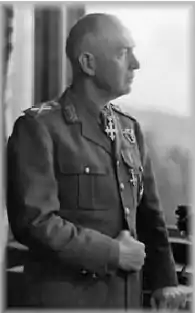 |
Marshal of Romania | Order of Michael the Brave | Prime Minister of Romania
Commander-in-Chief of Romanian Armed Forces |
Executed in 1946. | |
| Took control of Romania when Carol II abdicated and established a fascist dictatorship with the Iron Guard Party. Acted as Commander-in-Chief of the Romanian Army and Conducător of Romania, recapturing Bessarabia and northern Bucovina, then appointed himself marshal. When his forces were decimated at the Battle of Stalingrad, he started negotiating for peace . His career ended in 1944 when he was arrested by King Michael, who signed an armistice with the Allies.[1] | |||||||
| Petre Dumitrescu |  |
General | Knight's Cross of the Iron Cross with Oak Leaves | General Officer Commanding, Romanian Third Army | Died in 1950 after a bout with cancer. | ||
| Commanded the Romanian First Army between 1940 and 1941. Commanded the Romanian Third Army between 1941 and 1944. | |||||||
| Constantin Constantinescu-Claps | General | Order of Michael the Brave | General Officer Commanding, Romanian Fourth Army | Died in 1961. | |||
| Commanded the Romanian Fourth Army between 1941 and 1943. | |||||||
| Gheorghe Avramescu |  |
General | German Cross in Gold | General Officer Commanding, 10th Division
General Officer Commanding, Mountain Corps General Officer Commanding, III Corps General Officer Commanding, VI Corps |
Died in 1945. | ||
| Commanded the Romanian Mountain Corps between 1941 and 1943. Commanded the Romanian Fourth Army between 1944 and 1945. | |||||||
| Ioan Mihail Racoviță |  |
General | Order of Michael the Brave | General Officer Commanding, Romanian Cavalry Corps | Died in 1954. | ||
| Commanded the Romanian Cavalry Corps between 1941 and 1943. Commanded the Romanian Mechanized Troops between 1943 and 1944. | |||||||
| Vasile Atanasiu |  |
General | Order of the White Lion | General Officer Commanding, 1st Romanian Army | Died in 1964. | ||
| Commanded the 3rd Army Corps in the liberation of Bessarabia, the battle for the beachhead of Albiţa on the Prut River, the advance to the Dniester at Tiraspol between 1941 and 1943. Commanded the Romanian First Army in 1945, in the battles on the Czechoslovakian front in the Javorina, between the rivers Hron and Morava and thereafter in Bohemia. | |||||||
| Mihail Lascăr |  |
General | Knight's Cross of the Iron Cross with Oak Leaves | Died in 1959. | |||
| Commanded the 1st Mixed Mountain Brigade, an elite unit of the Romanian Third Army between 1941 and 1942. Commanded the 6th Division of the Romanian Third Army in 1942. Was taken prisoner at the Battle of Stalingrad and became commander of the Romanian Fourth Army in 1945. | |||||||
| Constantin Sănătescu |  |
General | General Officer Commanding, 4th Army Corps | Died in 1948. | |||
| Commanded the 4th Army Corps between 1941 and 1943. Commanded the Romanian Fourth Army between 1943 and 1944. Major participant in the 1944 Romanian coup d'état. | |||||||
| Constantin Nicolescu |  |
Lieutenant General | Order of Michael the Brave | Minister of Defense of Romania | Died in 1972. | ||
| Commanded the Bucharest Military between 1941 and 1943. Commanded the 4th Army Corps between 1943 and 1944. Was among the generals who prepared the King Michael Coup, and from November 1944 until the abolition of the monarchy in December 1947 served as head of the royal household. | |||||||
| Corneliu Dragalina |  |
Lieutenant General | Knight's Cross of the Iron Cross | Governor-General of Bukovina | Died in 1949. | ||
| Commanded the 6th Army Corps between 1940 and 1943. | |||||||
| Ioan Dumitrache |  |
Major General | Knight's Cross of the Iron Cross | General Officer Commanding, 2nd Mountain Division | Died in 1977. | ||
| Commanded the 2nd Mountain Division between 1942 and 1944. Was promoted to major general in 1944 and commanded the Romanian Mountain Corps. | |||||||
| Gheorghe Manoliu | Major General | Knight's Cross of the Iron Cross | General Officer Commanding, 4th Mountain Division | Died in 1974. | |||
| Commanded the 4th Mountain Division between 1940 and 1942. Was promoted to major general in 1943 and commanded the 4th Army Corps. | |||||||
| Emanoil Bârzotescu |  |
Major General | Order of the Crown (Romania) | General Officer Commanding, 1st Division
General Officer Commanding, 6th Corps |
Died in 1968. | ||
| Commanded the 1st Infantry Division between 1940 and 1942. Retired in 1942 and was recalled in 1945. Commanded the 6th Crops Area in 1945. | |||||||
| Dumitru Dămăceanu | 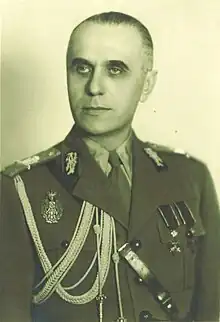 |
Brigadier General | Order of Michael the Brave | General Officer Commanding, 10th Roșiori Cavalry Regiment
General Officer Commanding, Capital Military Command |
Died in 1978. | ||
| Commanded the 10th Cavalry Regiment between 1941 and 1942. Chief of Staff in Bucharest Military between 1942 and 1944. Major participant in King Michael's Coup of 1944. | |||||||
| Leonard Mociulschi |  |
Brigadier General | Knight's Cross of the Iron Cross | Died in 1979. | |||
| Commanded the 1st Mixed Mountain Brigade, an elite unit of the Romanian Third Army between 1940 and 1941. Commanded the 3rd Mixed Mountain Brigade between 1942 and 1943. | |||||||
| Corneliu Teodorini |  |
Brigadier General | Knight's Cross of the Iron Cross with Oak Leaves | Died in 1976. | |||
| Commanded the 6th Cavalry Regiment. | |||||||
| Navy | Horia Macellariu |  |
Rear Admiral | Knight's Cross of the Iron Cross | Commander-in-Chief, Black Sea Fleet | Died in 1989. | |
| Commanded the Royal Romanian Navy's Black Sea Fleet between 1941 and 1944. | |||||||
Slovakia
| Armed Force | Name | Highest Rank | Highest Award | Commands | Fate | Theatres / Battles | |
|---|---|---|---|---|---|---|---|
| Army | Ferdinand Čatloš | Major General | General Officer Commanding, Field Army Bernolák | Was briefly imprisoned, set free in 1948, died in 1972. | |||
| Slovakian Minister of Defence and Chief General Staff. | |||||||
Bulgaria
Others
Finland
| Armed Force | Name | Highest Rank | Highest Award | Commands | Fate | Theatres / Battles | |
|---|---|---|---|---|---|---|---|
| Army | Carl Gustaf Emil Mannerheim |  |
Marshal of Finland | Grand Cross of the Order of the Cross of Liberty | Commander-in-Chief of the Finnish Defence Forces | Succeeded Risto Ryti as President of Finland. Died in 1951 | |
| Was Commander-in-Chief of Finnish army during World War II. Organised the Mannerheim Line in the Karelian Peninsula.[1] | |||||||
| Karl Lennart Oesch |  |
Lieutenant General | Mannerheim Cross | Commander, II Corps | Died in 1978 | ||
| An influential Finnish general. II Corps and III Corps of the Finnish ground forces were under his command at the end of the Continuation War. | |||||||
| Ruben Lagus |  |
Lieutenant General | Mannerheim Cross | Commander, Finnish Armoured Division | Died in 1959. |
| |
| Commanded the Finnish Armoured Division (Panssaridivisioona) during the Lapland War. | |||||||
| Erik Heinrichs |  |
General | Mannerheim Cross | Commander, III Corps | Died in 1965. | ||
| Commanded the Army of Karelia and the Army of the Isthmus. | |||||||
| Vilho Nenonen |  |
General | Mannerheim Cross | Died in 1960. | |||
| He was extremely influential in the development of the Finnish Army's artillery. The trajectory calculation formulas he developed are still in use today by modern artillery. | |||||||
| Paavo Talvela |  |
General | Mannerheim Cross | Commander, IV Corps | Died in 1973. | ||
| He commanded the Finnish III Corps in the Winter War from February 1940 to the end of the Winter War. | |||||||
Burma
| Armed Force | Name | Highest Rank | Highest Award | Commands | Fate | Theatres / Battles | |
|---|---|---|---|---|---|---|---|
| Army | Aung San |  |
Major General | Order of the Star of the Revolution | Leader of the Thirty Comrades | Arranged for the establishment of Burmese independence, assassinated under mysterious circumstances in 1947. | |
| Led the Burma National Army and the Anti-Fascist Organisation. | |||||||
Ukraine
| Armed Force | Name | Highest Rank | Highest Award | Commands | Fate | Theatres / Battles | |
|---|---|---|---|---|---|---|---|
| Army | Roman Shukhevych |  |
General | Gold Cross of Combat Merit First Class, the Cross of Merit in gold | Supreme Commander of the Ukrainian Insurgent Army | Died fighting NKVD forces in Lviv in 1950. | |
| Supreme commander of the Ukrainian Insurgent Army. | |||||||
See also
References
- 1 2 3 4 5 6 7 8 9 10 11 12 13 14 15 16 17 18 19 20 21 22 23 24 25 26 27 28 29 30 31 32 33 34 35 36 37 38 39 40 41 42 43 44 45 46 47 48 49 50 51 52 53 54 55 56 57 58 59 60 61 62 63 64 65 66 67 68 69 70 71 72 73 74 75 76 77 I.C.B Dear; M.R.D. Foot (2005). Oxford Companion to the Second World War (paperback ed.). Oxford University Press. ISBN 978-0-19-280666-6.
- ↑ Lord Ismay (2001). NATO, the first 5 years. NATO archives.
- ↑ C A Portal_P
- ↑ Ossad, Steven L., Command Failures: Lessons Learned from Lloyd R. Fredendall, Army Magazine, March 2003
- ↑ "Fleet Admiral Halsey Jr Profile at Naval Historical center". Retrieved 3 January 2007.
- ↑ Youngest General WW1 Archived 15 October 2013 at the Wayback Machine
- ↑ Freyberg - Archives from Italy
- ↑ "He fought to the bitter end". Archived from the original on 15 March 2008.
- ↑ "Décès du Colonel E. Speller, Aide de Camp de S. A. R. Madame la Grande-Duchesse de Luxembourg" (PDF). Grand Duché de Luxembourg Ministére D'État Bulletin D'Information (in French). Vol. 8, no. 12. Luxembourg: Service information et presse. 29 February 1952. p. 30. Archived from the original (PDF) on 22 August 2016. Retrieved 13 January 2018.
- ↑ Incerti, Corrado. "Borghese: indigestione o veleno?" (PDF). Retrieved 8 December 2014.





.jpg.webp)
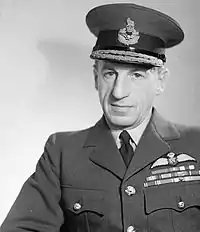



.jpg.webp)





.jpg.webp)


